Analyzing Firm Value: Chapter 2 and 3 Reflection Assignment
VerifiedAdded on 2022/08/24
|8
|1789
|16
Homework Assignment
AI Summary
This assignment presents a student's reflection on Chapters 2 and 3 of a finance study guide, focusing on how a firm adds value and methods for assessing that value. The student explores the concept of 'persistent stuff' and underlying identity in investment, emphasizing the importance of understanding a firm's strategy. The reflection discusses key concepts, including the difference between past and future investments, the role of business strategy in value creation, and the analysis of financial statements. It also covers the history and application of financial ratios, the importance of understanding what adds value, and the dividend conundrum. The student highlights the significance of analyzing financial statements to understand a firm's strategy and the accuracy of financial accounts, along with the evolution of financial analysis techniques. The student also reflects on the evolution of financial ratios and their application in valuing equity interests, emphasizing the importance of focusing on profits and cash flows to assess a firm's value-adding activities. The assignment provides a personal engagement with the reading, including reactions, questions, and understanding of the key concepts presented in the chapters.
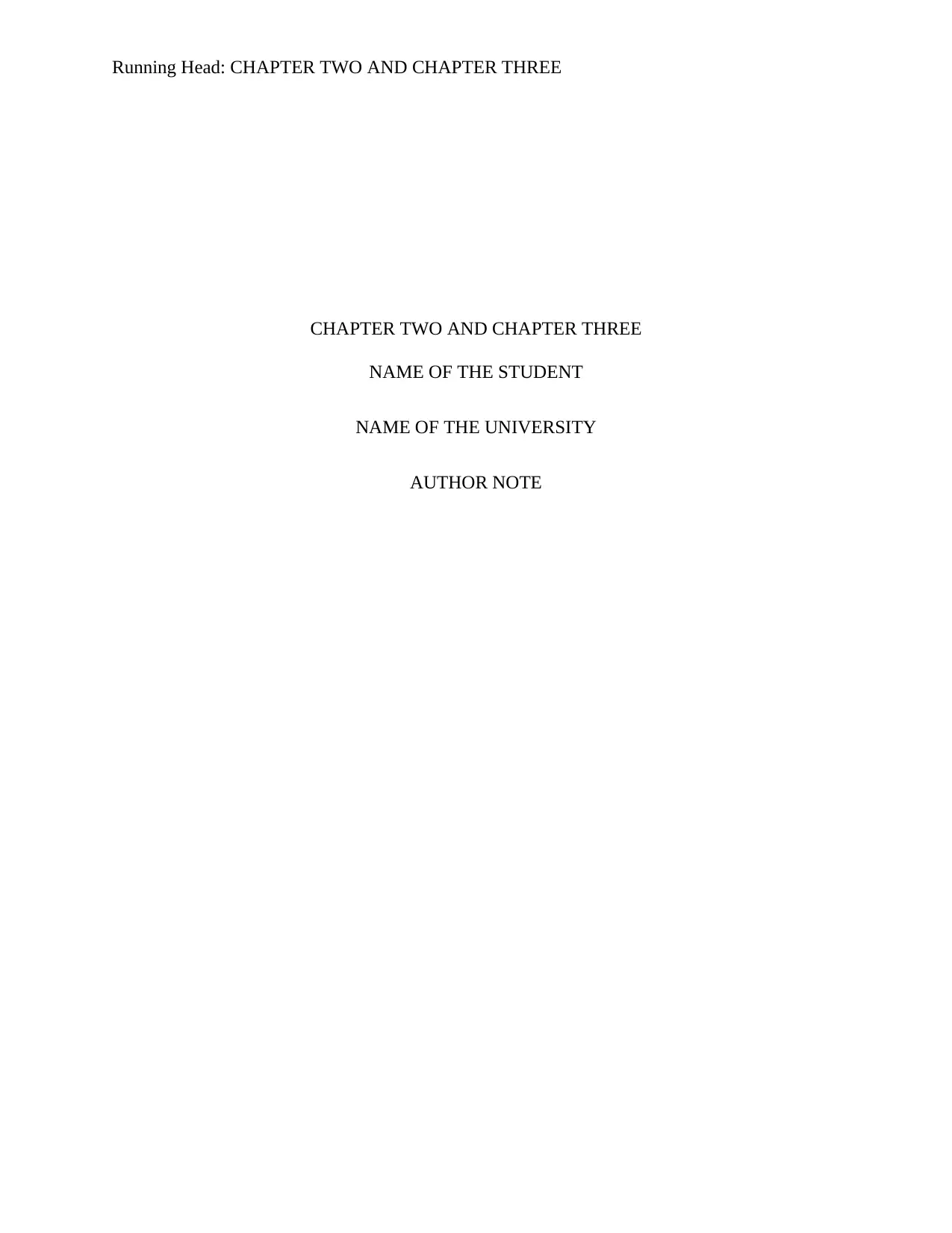
Running Head: CHAPTER TWO AND CHAPTER THREE
CHAPTER TWO AND CHAPTER THREE
NAME OF THE STUDENT
NAME OF THE UNIVERSITY
AUTHOR NOTE
CHAPTER TWO AND CHAPTER THREE
NAME OF THE STUDENT
NAME OF THE UNIVERSITY
AUTHOR NOTE
Paraphrase This Document
Need a fresh take? Get an instant paraphrase of this document with our AI Paraphraser
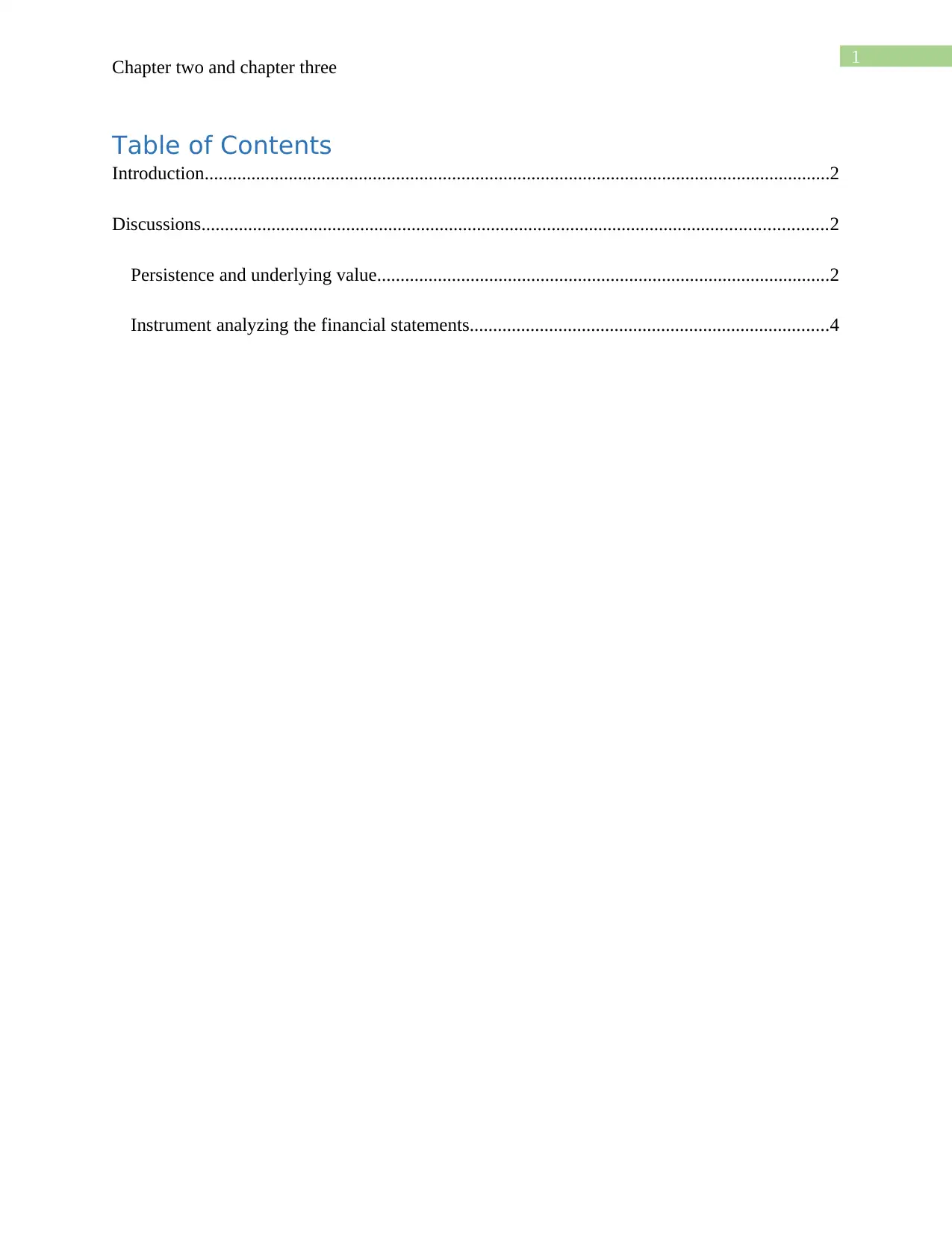
1
Chapter two and chapter three
Table of Contents
Introduction......................................................................................................................................2
Discussions......................................................................................................................................2
Persistence and underlying value.................................................................................................2
Instrument analyzing the financial statements.............................................................................4
Chapter two and chapter three
Table of Contents
Introduction......................................................................................................................................2
Discussions......................................................................................................................................2
Persistence and underlying value.................................................................................................2
Instrument analyzing the financial statements.............................................................................4
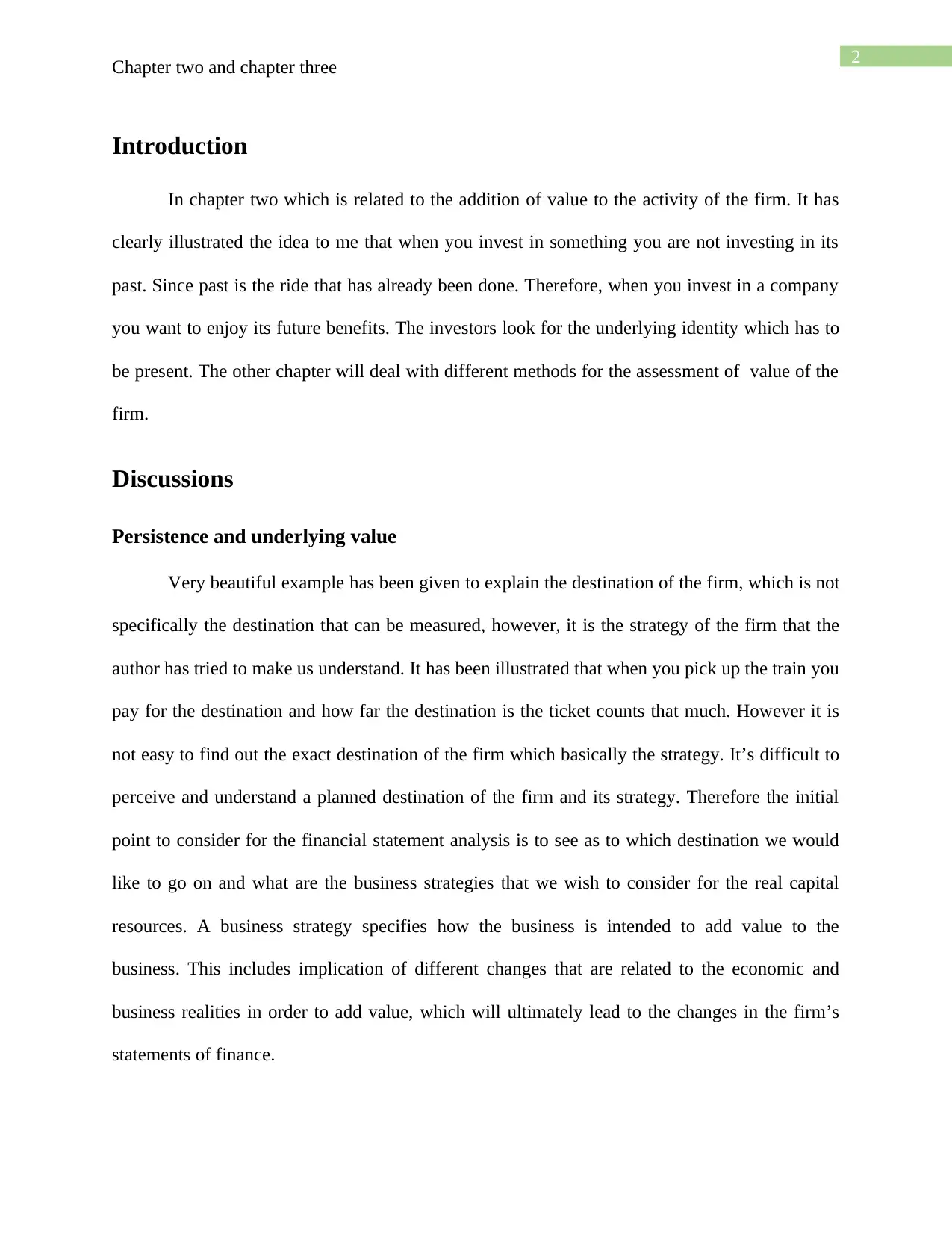
2
Chapter two and chapter three
Introduction
In chapter two which is related to the addition of value to the activity of the firm. It has
clearly illustrated the idea to me that when you invest in something you are not investing in its
past. Since past is the ride that has already been done. Therefore, when you invest in a company
you want to enjoy its future benefits. The investors look for the underlying identity which has to
be present. The other chapter will deal with different methods for the assessment of value of the
firm.
Discussions
Persistence and underlying value
Very beautiful example has been given to explain the destination of the firm, which is not
specifically the destination that can be measured, however, it is the strategy of the firm that the
author has tried to make us understand. It has been illustrated that when you pick up the train you
pay for the destination and how far the destination is the ticket counts that much. However it is
not easy to find out the exact destination of the firm which basically the strategy. It’s difficult to
perceive and understand a planned destination of the firm and its strategy. Therefore the initial
point to consider for the financial statement analysis is to see as to which destination we would
like to go on and what are the business strategies that we wish to consider for the real capital
resources. A business strategy specifies how the business is intended to add value to the
business. This includes implication of different changes that are related to the economic and
business realities in order to add value, which will ultimately lead to the changes in the firm’s
statements of finance.
Chapter two and chapter three
Introduction
In chapter two which is related to the addition of value to the activity of the firm. It has
clearly illustrated the idea to me that when you invest in something you are not investing in its
past. Since past is the ride that has already been done. Therefore, when you invest in a company
you want to enjoy its future benefits. The investors look for the underlying identity which has to
be present. The other chapter will deal with different methods for the assessment of value of the
firm.
Discussions
Persistence and underlying value
Very beautiful example has been given to explain the destination of the firm, which is not
specifically the destination that can be measured, however, it is the strategy of the firm that the
author has tried to make us understand. It has been illustrated that when you pick up the train you
pay for the destination and how far the destination is the ticket counts that much. However it is
not easy to find out the exact destination of the firm which basically the strategy. It’s difficult to
perceive and understand a planned destination of the firm and its strategy. Therefore the initial
point to consider for the financial statement analysis is to see as to which destination we would
like to go on and what are the business strategies that we wish to consider for the real capital
resources. A business strategy specifies how the business is intended to add value to the
business. This includes implication of different changes that are related to the economic and
business realities in order to add value, which will ultimately lead to the changes in the firm’s
statements of finance.
⊘ This is a preview!⊘
Do you want full access?
Subscribe today to unlock all pages.

Trusted by 1+ million students worldwide
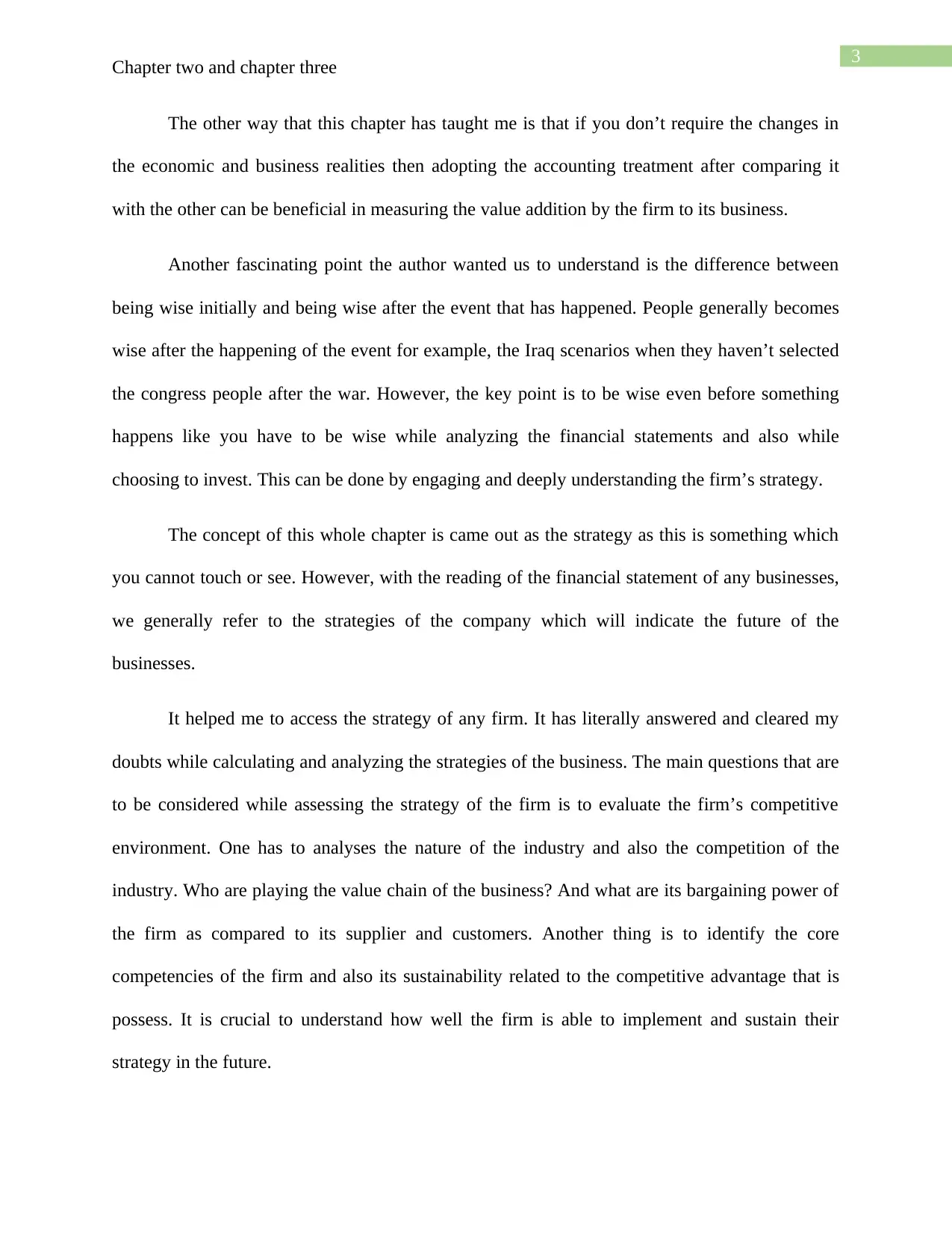
3
Chapter two and chapter three
The other way that this chapter has taught me is that if you don’t require the changes in
the economic and business realities then adopting the accounting treatment after comparing it
with the other can be beneficial in measuring the value addition by the firm to its business.
Another fascinating point the author wanted us to understand is the difference between
being wise initially and being wise after the event that has happened. People generally becomes
wise after the happening of the event for example, the Iraq scenarios when they haven’t selected
the congress people after the war. However, the key point is to be wise even before something
happens like you have to be wise while analyzing the financial statements and also while
choosing to invest. This can be done by engaging and deeply understanding the firm’s strategy.
The concept of this whole chapter is came out as the strategy as this is something which
you cannot touch or see. However, with the reading of the financial statement of any businesses,
we generally refer to the strategies of the company which will indicate the future of the
businesses.
It helped me to access the strategy of any firm. It has literally answered and cleared my
doubts while calculating and analyzing the strategies of the business. The main questions that are
to be considered while assessing the strategy of the firm is to evaluate the firm’s competitive
environment. One has to analyses the nature of the industry and also the competition of the
industry. Who are playing the value chain of the business? And what are its bargaining power of
the firm as compared to its supplier and customers. Another thing is to identify the core
competencies of the firm and also its sustainability related to the competitive advantage that is
possess. It is crucial to understand how well the firm is able to implement and sustain their
strategy in the future.
Chapter two and chapter three
The other way that this chapter has taught me is that if you don’t require the changes in
the economic and business realities then adopting the accounting treatment after comparing it
with the other can be beneficial in measuring the value addition by the firm to its business.
Another fascinating point the author wanted us to understand is the difference between
being wise initially and being wise after the event that has happened. People generally becomes
wise after the happening of the event for example, the Iraq scenarios when they haven’t selected
the congress people after the war. However, the key point is to be wise even before something
happens like you have to be wise while analyzing the financial statements and also while
choosing to invest. This can be done by engaging and deeply understanding the firm’s strategy.
The concept of this whole chapter is came out as the strategy as this is something which
you cannot touch or see. However, with the reading of the financial statement of any businesses,
we generally refer to the strategies of the company which will indicate the future of the
businesses.
It helped me to access the strategy of any firm. It has literally answered and cleared my
doubts while calculating and analyzing the strategies of the business. The main questions that are
to be considered while assessing the strategy of the firm is to evaluate the firm’s competitive
environment. One has to analyses the nature of the industry and also the competition of the
industry. Who are playing the value chain of the business? And what are its bargaining power of
the firm as compared to its supplier and customers. Another thing is to identify the core
competencies of the firm and also its sustainability related to the competitive advantage that is
possess. It is crucial to understand how well the firm is able to implement and sustain their
strategy in the future.
Paraphrase This Document
Need a fresh take? Get an instant paraphrase of this document with our AI Paraphraser
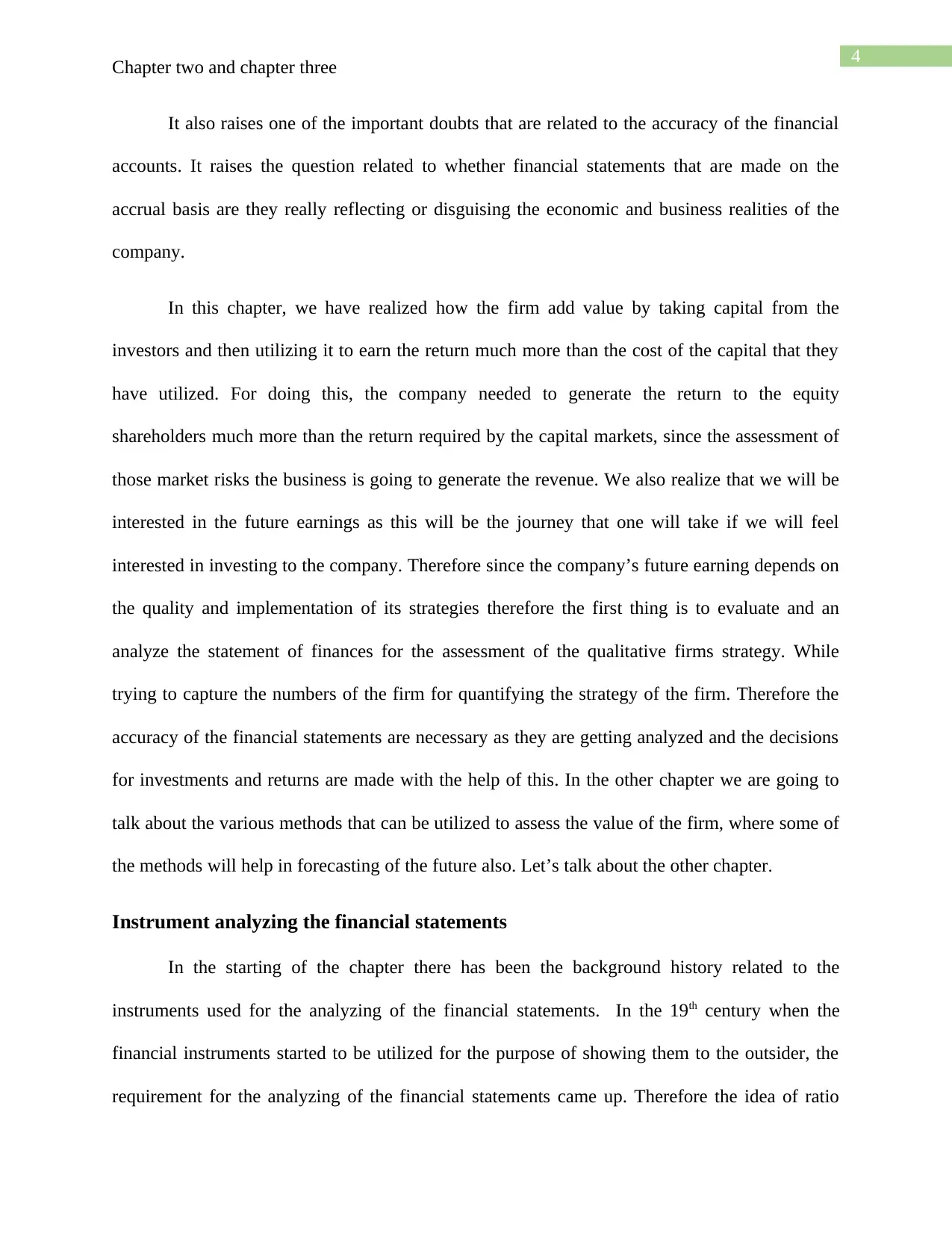
4
Chapter two and chapter three
It also raises one of the important doubts that are related to the accuracy of the financial
accounts. It raises the question related to whether financial statements that are made on the
accrual basis are they really reflecting or disguising the economic and business realities of the
company.
In this chapter, we have realized how the firm add value by taking capital from the
investors and then utilizing it to earn the return much more than the cost of the capital that they
have utilized. For doing this, the company needed to generate the return to the equity
shareholders much more than the return required by the capital markets, since the assessment of
those market risks the business is going to generate the revenue. We also realize that we will be
interested in the future earnings as this will be the journey that one will take if we will feel
interested in investing to the company. Therefore since the company’s future earning depends on
the quality and implementation of its strategies therefore the first thing is to evaluate and an
analyze the statement of finances for the assessment of the qualitative firms strategy. While
trying to capture the numbers of the firm for quantifying the strategy of the firm. Therefore the
accuracy of the financial statements are necessary as they are getting analyzed and the decisions
for investments and returns are made with the help of this. In the other chapter we are going to
talk about the various methods that can be utilized to assess the value of the firm, where some of
the methods will help in forecasting of the future also. Let’s talk about the other chapter.
Instrument analyzing the financial statements
In the starting of the chapter there has been the background history related to the
instruments used for the analyzing of the financial statements. In the 19th century when the
financial instruments started to be utilized for the purpose of showing them to the outsider, the
requirement for the analyzing of the financial statements came up. Therefore the idea of ratio
Chapter two and chapter three
It also raises one of the important doubts that are related to the accuracy of the financial
accounts. It raises the question related to whether financial statements that are made on the
accrual basis are they really reflecting or disguising the economic and business realities of the
company.
In this chapter, we have realized how the firm add value by taking capital from the
investors and then utilizing it to earn the return much more than the cost of the capital that they
have utilized. For doing this, the company needed to generate the return to the equity
shareholders much more than the return required by the capital markets, since the assessment of
those market risks the business is going to generate the revenue. We also realize that we will be
interested in the future earnings as this will be the journey that one will take if we will feel
interested in investing to the company. Therefore since the company’s future earning depends on
the quality and implementation of its strategies therefore the first thing is to evaluate and an
analyze the statement of finances for the assessment of the qualitative firms strategy. While
trying to capture the numbers of the firm for quantifying the strategy of the firm. Therefore the
accuracy of the financial statements are necessary as they are getting analyzed and the decisions
for investments and returns are made with the help of this. In the other chapter we are going to
talk about the various methods that can be utilized to assess the value of the firm, where some of
the methods will help in forecasting of the future also. Let’s talk about the other chapter.
Instrument analyzing the financial statements
In the starting of the chapter there has been the background history related to the
instruments used for the analyzing of the financial statements. In the 19th century when the
financial instruments started to be utilized for the purpose of showing them to the outsider, the
requirement for the analyzing of the financial statements came up. Therefore the idea of ratio
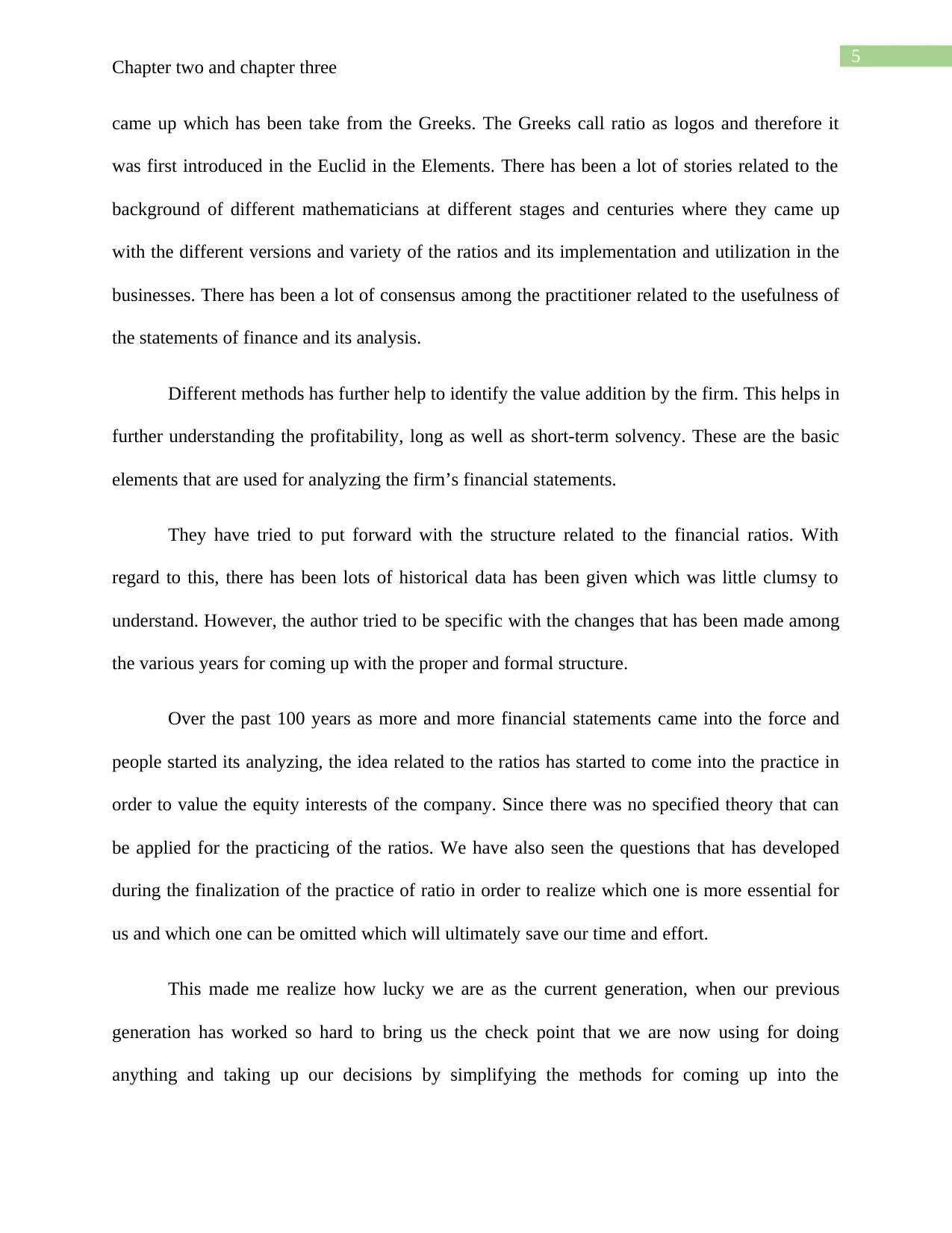
5
Chapter two and chapter three
came up which has been take from the Greeks. The Greeks call ratio as logos and therefore it
was first introduced in the Euclid in the Elements. There has been a lot of stories related to the
background of different mathematicians at different stages and centuries where they came up
with the different versions and variety of the ratios and its implementation and utilization in the
businesses. There has been a lot of consensus among the practitioner related to the usefulness of
the statements of finance and its analysis.
Different methods has further help to identify the value addition by the firm. This helps in
further understanding the profitability, long as well as short-term solvency. These are the basic
elements that are used for analyzing the firm’s financial statements.
They have tried to put forward with the structure related to the financial ratios. With
regard to this, there has been lots of historical data has been given which was little clumsy to
understand. However, the author tried to be specific with the changes that has been made among
the various years for coming up with the proper and formal structure.
Over the past 100 years as more and more financial statements came into the force and
people started its analyzing, the idea related to the ratios has started to come into the practice in
order to value the equity interests of the company. Since there was no specified theory that can
be applied for the practicing of the ratios. We have also seen the questions that has developed
during the finalization of the practice of ratio in order to realize which one is more essential for
us and which one can be omitted which will ultimately save our time and effort.
This made me realize how lucky we are as the current generation, when our previous
generation has worked so hard to bring us the check point that we are now using for doing
anything and taking up our decisions by simplifying the methods for coming up into the
Chapter two and chapter three
came up which has been take from the Greeks. The Greeks call ratio as logos and therefore it
was first introduced in the Euclid in the Elements. There has been a lot of stories related to the
background of different mathematicians at different stages and centuries where they came up
with the different versions and variety of the ratios and its implementation and utilization in the
businesses. There has been a lot of consensus among the practitioner related to the usefulness of
the statements of finance and its analysis.
Different methods has further help to identify the value addition by the firm. This helps in
further understanding the profitability, long as well as short-term solvency. These are the basic
elements that are used for analyzing the firm’s financial statements.
They have tried to put forward with the structure related to the financial ratios. With
regard to this, there has been lots of historical data has been given which was little clumsy to
understand. However, the author tried to be specific with the changes that has been made among
the various years for coming up with the proper and formal structure.
Over the past 100 years as more and more financial statements came into the force and
people started its analyzing, the idea related to the ratios has started to come into the practice in
order to value the equity interests of the company. Since there was no specified theory that can
be applied for the practicing of the ratios. We have also seen the questions that has developed
during the finalization of the practice of ratio in order to realize which one is more essential for
us and which one can be omitted which will ultimately save our time and effort.
This made me realize how lucky we are as the current generation, when our previous
generation has worked so hard to bring us the check point that we are now using for doing
anything and taking up our decisions by simplifying the methods for coming up into the
⊘ This is a preview!⊘
Do you want full access?
Subscribe today to unlock all pages.

Trusted by 1+ million students worldwide
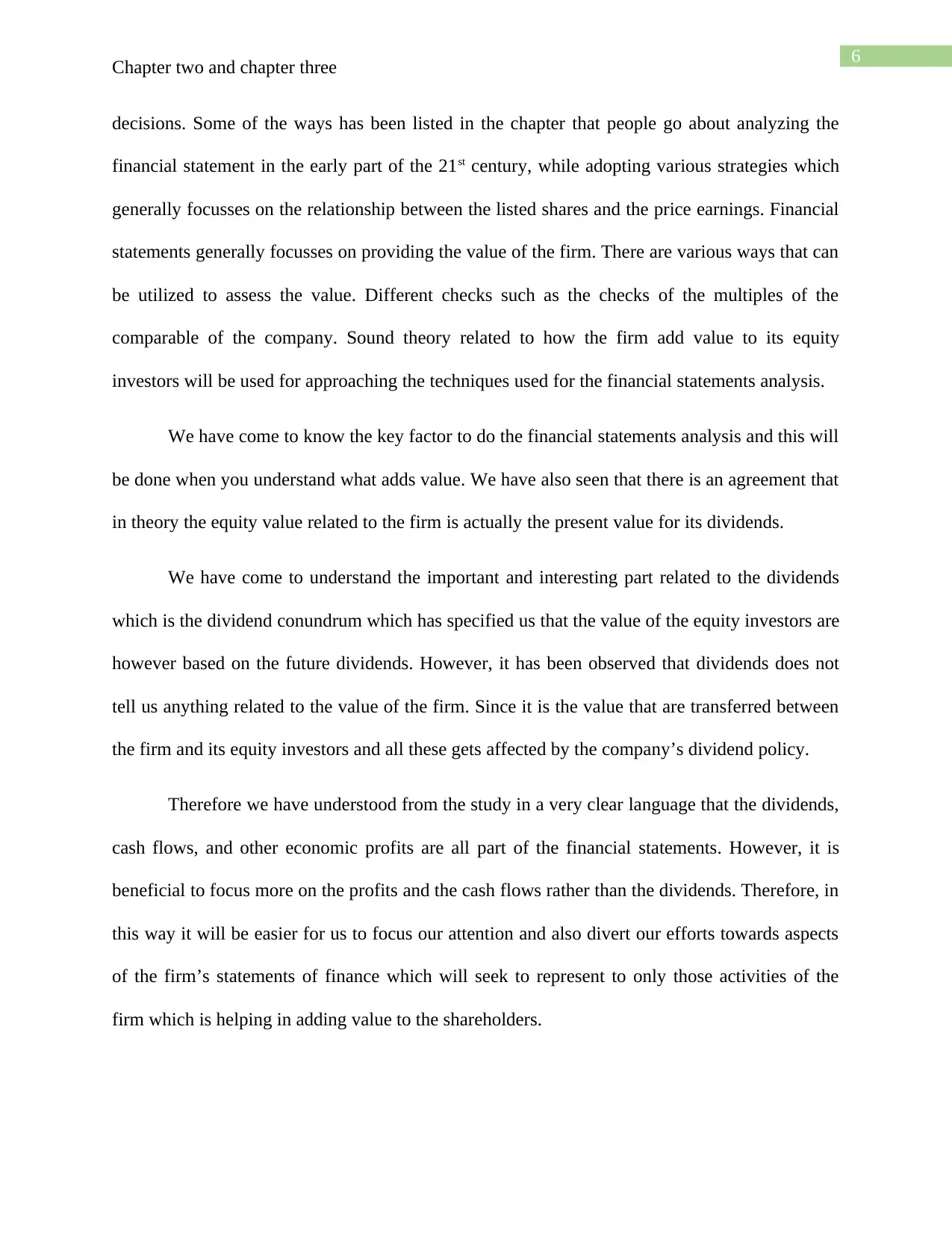
6
Chapter two and chapter three
decisions. Some of the ways has been listed in the chapter that people go about analyzing the
financial statement in the early part of the 21st century, while adopting various strategies which
generally focusses on the relationship between the listed shares and the price earnings. Financial
statements generally focusses on providing the value of the firm. There are various ways that can
be utilized to assess the value. Different checks such as the checks of the multiples of the
comparable of the company. Sound theory related to how the firm add value to its equity
investors will be used for approaching the techniques used for the financial statements analysis.
We have come to know the key factor to do the financial statements analysis and this will
be done when you understand what adds value. We have also seen that there is an agreement that
in theory the equity value related to the firm is actually the present value for its dividends.
We have come to understand the important and interesting part related to the dividends
which is the dividend conundrum which has specified us that the value of the equity investors are
however based on the future dividends. However, it has been observed that dividends does not
tell us anything related to the value of the firm. Since it is the value that are transferred between
the firm and its equity investors and all these gets affected by the company’s dividend policy.
Therefore we have understood from the study in a very clear language that the dividends,
cash flows, and other economic profits are all part of the financial statements. However, it is
beneficial to focus more on the profits and the cash flows rather than the dividends. Therefore, in
this way it will be easier for us to focus our attention and also divert our efforts towards aspects
of the firm’s statements of finance which will seek to represent to only those activities of the
firm which is helping in adding value to the shareholders.
Chapter two and chapter three
decisions. Some of the ways has been listed in the chapter that people go about analyzing the
financial statement in the early part of the 21st century, while adopting various strategies which
generally focusses on the relationship between the listed shares and the price earnings. Financial
statements generally focusses on providing the value of the firm. There are various ways that can
be utilized to assess the value. Different checks such as the checks of the multiples of the
comparable of the company. Sound theory related to how the firm add value to its equity
investors will be used for approaching the techniques used for the financial statements analysis.
We have come to know the key factor to do the financial statements analysis and this will
be done when you understand what adds value. We have also seen that there is an agreement that
in theory the equity value related to the firm is actually the present value for its dividends.
We have come to understand the important and interesting part related to the dividends
which is the dividend conundrum which has specified us that the value of the equity investors are
however based on the future dividends. However, it has been observed that dividends does not
tell us anything related to the value of the firm. Since it is the value that are transferred between
the firm and its equity investors and all these gets affected by the company’s dividend policy.
Therefore we have understood from the study in a very clear language that the dividends,
cash flows, and other economic profits are all part of the financial statements. However, it is
beneficial to focus more on the profits and the cash flows rather than the dividends. Therefore, in
this way it will be easier for us to focus our attention and also divert our efforts towards aspects
of the firm’s statements of finance which will seek to represent to only those activities of the
firm which is helping in adding value to the shareholders.
Paraphrase This Document
Need a fresh take? Get an instant paraphrase of this document with our AI Paraphraser

7
Chapter two and chapter three
Chapter two and chapter three
1 out of 8
Related Documents
Your All-in-One AI-Powered Toolkit for Academic Success.
+13062052269
info@desklib.com
Available 24*7 on WhatsApp / Email
![[object Object]](/_next/static/media/star-bottom.7253800d.svg)
Unlock your academic potential
Copyright © 2020–2025 A2Z Services. All Rights Reserved. Developed and managed by ZUCOL.




![Financial Statement Analysis Homework - [University Name] - Semester 1](/_next/image/?url=https%3A%2F%2Fdesklib.com%2Fmedia%2Fimages%2Fpl%2F94032add73c5467f81c103edfc1a6f31.jpg&w=256&q=75)
